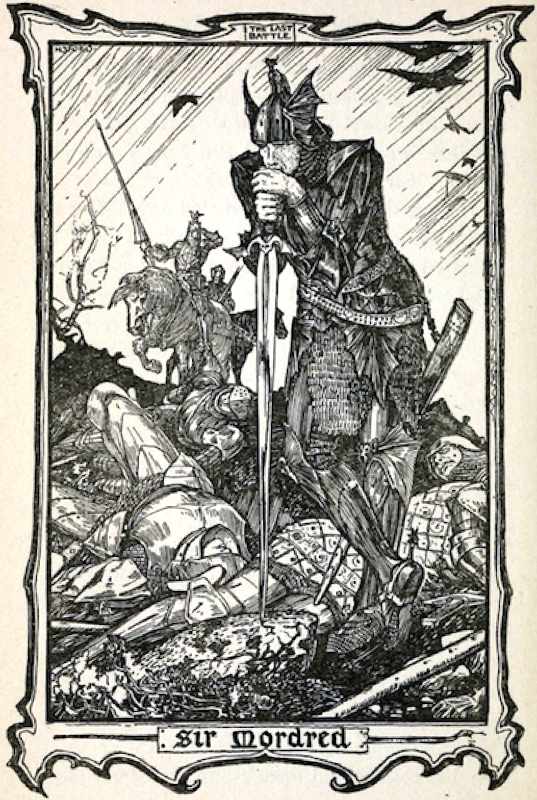Mordred or Modred is a figure who is variously portrayed in the legend of King Arthur. The earliest known mention of a possibly historical Medraut is in the Welsh chronicle Annales Cambriae, wherein he and Arthur are ambiguously associated with the Battle of Camlann in a brief entry for the year 537. His figure seemed to have been regarded positively in the early Welsh tradition and may have been related to that of Arthur’s son. As Modredus, Mordred was depicted as Arthur’s traitorous nephew and a legitimate son of King Lot in Geoffrey of Monmouth’s pseudo-historical work Historia Regum Britanniae which then served as the basis for the following evolution of the legend from the 12th century. Later variants most often characterized him as Arthur’s villainous bastard son, born of an incestuous relationship with his half-sister, the queen of Lothian or Orkney named either Anna, Orcades, or Morgause. The accounts presented in the Historia and most other versions include Mordred’s death at Camlann, typically in a final duel, during which he manages to mortally wound his slayer, Arthur. Mordred is usually a brother or half-brother to Gawain; however, his other family relations, as well as his relationships with Arthur’s wife Guinevere, vary greatly. In a popular telling originating from the French chivalric romances of the 13th century, and made prominent today through its inclusion in Le Morte d’Arthur, Mordred is knighted by Arthur and joins the fellowship of the Round Table. In this narrative, he eventually becomes the main actor in Arthur’s downfall: he helps his half-brother Agravain to expose the affair between Guinevere and Lancelot, and then takes advantage of the resulting civil war to make himself the high king of Britain.
| Alias Mordred |
| Real Names/Alt Names Mordred |
| Characteristics Villain, Arthurian Cycle, Medieval Age, British |
| Creators/Key Contributors Unknown |
| First Appearance Arthurian legend |
| First Publisher ○ |
| Appearance List Literary: Annales Cambriae (10th century), Historia Regum Britanniae (1136), The Vulgate Lancelot (1475), Le Morte d’Arthur (1485), Ballads of Bravery (1877), The Story of King Arthur and His Knights of the Round Table (1862), The Story of King Arthur and His Knights (1903), Stories of King Arthur and His Knights (1904), The Story of the Champions of the Round Table (1905), Idylls of the King (1913), Legends of King Arthur and His Knights (1914), Legends and Romances of Brittany (1917), The Legends of King Arthur and His Knights (1912). Comics: Robin Hood #53, Weird Comics #7, Catholic Comics #7-10, 13, Operation: Peril #3, Boy Comics #4, Jack-in-the-Box Comics #1, Robin Hood and His Merry Men #29, Blackhawk #42. |
| Sample Read The Boy’s King Arthur; Sir Thomas Malory’s History of King Arthur and his Knights of the Round Table [Internet Archive] |
| Description Mordred or Modred is a figure who is variously portrayed in the legend of King Arthur. The earliest known mention of a possibly historical Medraut is in the Welsh chronicle Annales Cambriae, wherein he and Arthur are ambiguously associated with the Battle of Camlann in a brief entry for the year 537. His figure seemed to have been regarded positively in the early Welsh tradition and may have been related to that of Arthur’s son. As Modredus, Mordred was depicted as Arthur’s traitorous nephew and a legitimate son of King Lot in Geoffrey of Monmouth’s pseudo-historical work Historia Regum Britanniae which then served as the basis for the following evolution of the legend from the 12th century. Later variants most often characterized him as Arthur’s villainous bastard son, born of an incestuous relationship with his half-sister, the queen of Lothian or Orkney named either Anna, Orcades, or Morgause. The accounts presented in the Historia and most other versions include Mordred’s death at Camlann, typically in a final duel, during which he manages to mortally wound his slayer, Arthur. Mordred is usually a brother or half-brother to Gawain; however, his other family relations, as well as his relationships with Arthur’s wife Guinevere, vary greatly. In a popular telling originating from the French chivalric romances of the 13th century, and made prominent today through its inclusion in Le Morte d’Arthur, Mordred is knighted by Arthur and joins the fellowship of the Round Table. In this narrative, he eventually becomes the main actor in Arthur’s downfall: he helps his half-brother Agravain to expose the affair between Guinevere and Lancelot, and then takes advantage of the resulting civil war to make himself the high king of Britain. |
| Source Mordred – Wikipedia |

